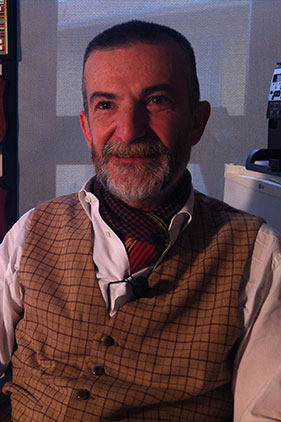May 2017, Year IX, no. 5
Marco Lombardi
Terrorism is communication
“An act becomes a terrorist act not because of its effects, but for the reasons that inspired it. This statement could be legally incorrect, but it’s true politically and socially, because the effects of those attacks are both political and social since they impact on the everyday lives of those communities”.
Telos: “After the attacks in Paris we are all at risk and we have to learn to live with this situation. We have to accept uncertainty, liquidity, the fact that we don’t know how safe we are”. These were your words in November 2015: what has happened since then?
Marco Lombardi: So many things have happened since 2015, but all of them confirmed our expectations that 2016 was going to be even more problematic, and that the difficulties in 2017 would follow suit. Daesh’s propaganda asking people not to leave to fight abroad, but rather stay and bring terror into their own country, has been successful. Above all, it has succeeded in making the conflict more “middle Eastern”, teaching people to use everyday weapons against the infidels: a knife, a car, a truck, fire and, in the near future, drones.
So everything has become even more uncertain and, hence, unpredictable. Just think back to the second half of the month of March 2017: on the 17th in Paris a man shouting “Allah Akbar” slit the throats of his brother and father; on the 18th in Orly, Ziyed Ben Belgacem attacked the airport, wrestled a gun from policeman, and shouted: “I am here to die in the name of Allah”; on the 22nd in Westminster, Khalid Masood used a car and a knife to attack Parliament; on the 23rd in Antwerp a madman called Mohamed tried to run down pedestrians in a shopping street and was arrested; on April 3, in Saint Petersburg, the subway was attacked.
Those eighteen very intense days, unlike almost none other in the past, were characterised by violence always perpetrated with a reference to Islamic terrorism: either an explicit act for which the terrorist agency (Amaq) claimed responsibility, or a person shouting the name of Allah, a modus operandi successfully promoted by Daesh, or a person with a past as a radical and fighter. Five attacks in eighteen days, one single source of inspiration, and a host of different reasons behind their implementation. However, I think it’s clear that an act becomes a terrorist act not because of its effects, but for the reasons that inspired it.
This could be legally incorrect, but it’s true politically and socially, because the effects of each of those five attacks were both political and social; they impacted on the everyday lives of those communities and created an institutional problem about how to control the situation, including internationally. “Terrorism” has become the manifest expression of an ideological, religious and nationalist belief, as well as of anger, madness and distress.
And anything else that is subjective, reinforced by a suitable media strategy, and requires violent implementation. In practice, terrorism is a diffuse form of conflict; terrorist organisations exploit its effects, promote this subjective form of conflict and use individuals to implement it. The result is a generalised inability to predict these attacks and a widespread increase in uncertainty.
If you mention ISIS today very few people will ask: ‘What’s that?’ Does the Caliphate have a communication plan?
The Caliphate was created to be “public” and has always “publicly” declared its goals and actions, so much so that it appears mimetic. Even before it was founded, it declared its objective: to found a Caliphate and be recognised as a State, first by the global Muslim community, and then by the international community. Its objective was manifest in the way it changed its name: ISI when it was created in Iraq (Islamic State of Iraq), ISIL or ISIS when it included Syria and the Levant, incorporating the mythical and symbolic references of the Sham into its name (Islamic State of Iraq and Syria, or Sham or even Levant); finally IS, simple and effectively Islamic State, when every geographical reference was superfluous because the Caliphate had become a supranational entity. Interest in its name is due not only to its geopolitical implications, but also because it is explicitly programmatic since the Islamists’ objective is now part of its name: “State”. The Daesh’s skilfully elaborated communication plan originates in the media interpretation of the Hybrid War.
You have studied international terrorism, especially Jihadist terrorism, for many years. What is the meaning of recruitment through radicalisation?
Daesh has attracted the highest number of international fighters since the Spanish War: the real issue is its ability to attract international Jihadists, foreign fighters who boost their ranks, but also people who can somehow support the Islamic State, including families. The results achieved by IS are certainly very appealing for the global jihad: the myth of a Caliphate is an extremely powerful and magnetic tool to attract people and promote radicalisation.
Today the Caliphate’s systematic proselytism towards radical Islamic groups has produced a widespread, scattered group of over forty Daesh affiliates in twenty-one countries. Some of these affiliates acknowledge the Daesh’s authority; others support it as sympathisers after declaring they belong to it. There are now many, but may I say, not very interesting channels for radicalisation, because all the reasons for affiliation (religious or political conviction, depression, anger, psychological illness, etc.) produce the same result: Daesh claims responsibility for the effects of a terrorist act, even if only instrumentally.
Terrorism has changed in recent years and the digital dimension now plays a key role. Can we use it to fight terrorism? And if so, how?
In its Report published in 2007 (Council on Global Terrorism) the US Department of Defence acknowledged that unclassified material available on the web provides 80% of the information needed to build an extremely powerful object. More recently, it’s above all cyberspace that has become an accelerator of radicalisation and recruitment. Since Internet is anonymous, numerous Islamic groups publish e-bulletins with radical contents; they exchange videos, create discussion forums and communicate using private chats. We can consider the web as a social factor for radicalisation and recruitment facilitating the creation of networks and interpersonal interaction.
The systematic monitoring of websites is also quite complicated because these sites are often temporary and have multiple levels; nevertheless, monitoring focuses meticulously on online audiovisual material but now has to also concentrate on even more “ephemeral” material, for example the material posted on social networks (FaceBook, Twitter, Youtube, etc.). The exponential development of the web has to be considered alongside all the other communication technologies available on different platforms (not just the computer, but above all smartphones); this has further simplified these operations and consolidated their daily use thanks to the celebration and pervasiveness of social networks that incorporate all the characteristics of previous systems.
Editorial
Everyday life in the time of terror. And we’re not talking about the French Revolution. Even though, after the attacks against our neighbour on the other side of the Alps, Paris and France play a key role in this debate. These attacks have apparently convinced Italians that even our lifestyle and the way we organise our travels is dangerous. The words lone wolf, foreign fighters and hybrid war have become sadly famous. This albeit superficial knowledge begs a question: is Italy the next target? We won’t even try to answer this impossible question, but given that terrorism and the fear it arouses will be around for many years we decided to interview Marco Lombardi, Professor at the Catholic University of Milan, and one of the major Italian experts in risk management and security and management policies. He is also the coordinator of ITSTIME, a centre for research on terrorism and the management of emergencies. The aim of this interview is to get a better understanding of the characteristics of this new terrorism and the crucial importance of an analyst’s role in helping institutions rethink regulatory tools and operational strategies in the fight against a phenomenon that is so different to what Italians lived through in the not so distant past. The clear-headed, articulate statements by Prof. Lombardi lead us on a journey of discovery of Jihadist terrorism, its history, and battle strategies based on an incredible ability to leverage communication, especially digital communication. The research by Prof. Lombardi and his team inspired us with the title of the interview. Lombardi says that there’s a big difference between a criminal and a terrorist. Terrorists are interested is the symbolic recognition provided by their action; they long for media visibility and want to be an acknowledged protagonist, if possible praised and emulated. Terrorism is communication and manages communication, and so communication must be used as a tool to interpret the phenomenon. ‘Think Terrorist’ - and I hope the team won’t take offence - is the motto of this extraordinary group that tries to disclose and help to contain Daesh by their in-depth research, including the technological dimension. Lombardi does not simply analyse the phenomenon, he helps to develop proactive strategies, such as counter-narrative and de/counter radicalisation, to be used together with traditional responses. We’re convinced that the more we know about terrorism, the more we will be able to confront our fears and blunt a very powerful weapon used by terrorists: our psychological vulnerability.

Marco Lombardi, is full time professor of Sociology, Crisis Management, Communication, International Cooperation at the Catholic University in Milan where he is director of the research centre ITSTIME (Italian Team for Security, Terroristic Issues & Managing Emergencies). Member of the scientific board of the International Doctorate of Criminology and the Master in the Relational Context of Emergency, he coordinates the activities of the Environment, Territory and Security of the Dept. of Sociology.
For over thirty years his research has focused on all aspects of crisis and emergency management, especially security and terrorism. He is also an expert on immigration many of his papers are part of the Statistical Dossiers on Immigration and for several years he has collaborated with the Ismu Foundation for Initiatives and Studies on Multi-ethnicity.
Lombardi works with several institutions on these issues and is, for example, a member of the Strategic Reflection Group (CRIS) of the Italian Ministry of Foreign Affairs; he is also a member of the Committee of Experts tasked with analysing the current state of Jihadist radicalisation and extremism. He is a consultant/expert of the Special Operations Group of the Carabinieri, especially as regards terrorism investigations. He is member of the editorial board of the and Scientific Advisor of the Global Terrorism Observatory of JD - Journal for Deradicalization and Scientific Advisor of the Global Terrorism Observatory of ISPI - Institute for international political studies.
He is part of the Expert group of the European Commission for “Justice, freedom and security” and collaborates with numerous institutional Agencies involved in the field of Security, for example the Italian Defense Higher Studies Institute (CASD) and the Military Centre for Strategic Studies (CeMISS). He has published several papers and books and participated as a rapporteur in numerous international conferences. He was born in Milan, is 60 years old, married and loves to ski.







SocialTelos